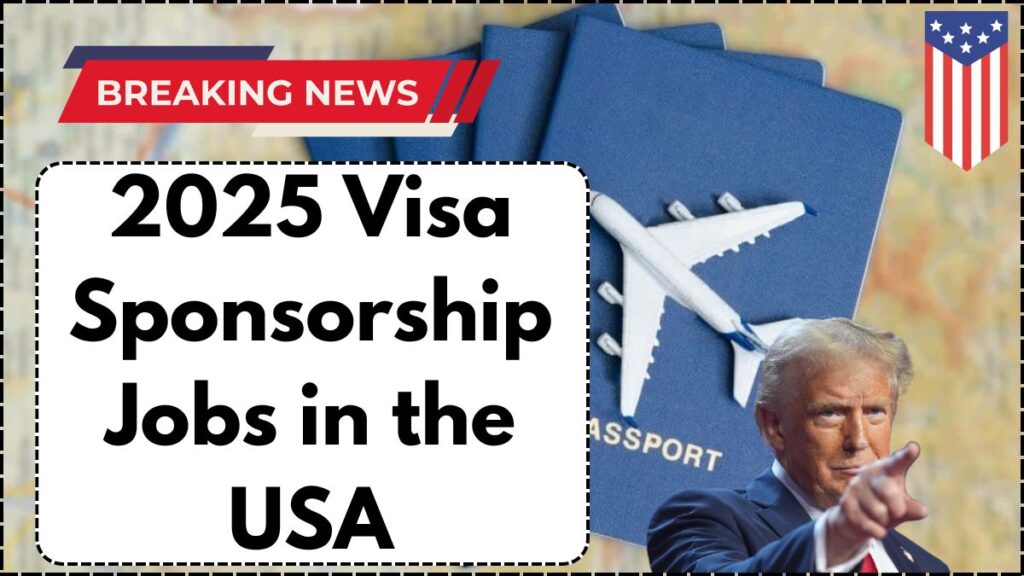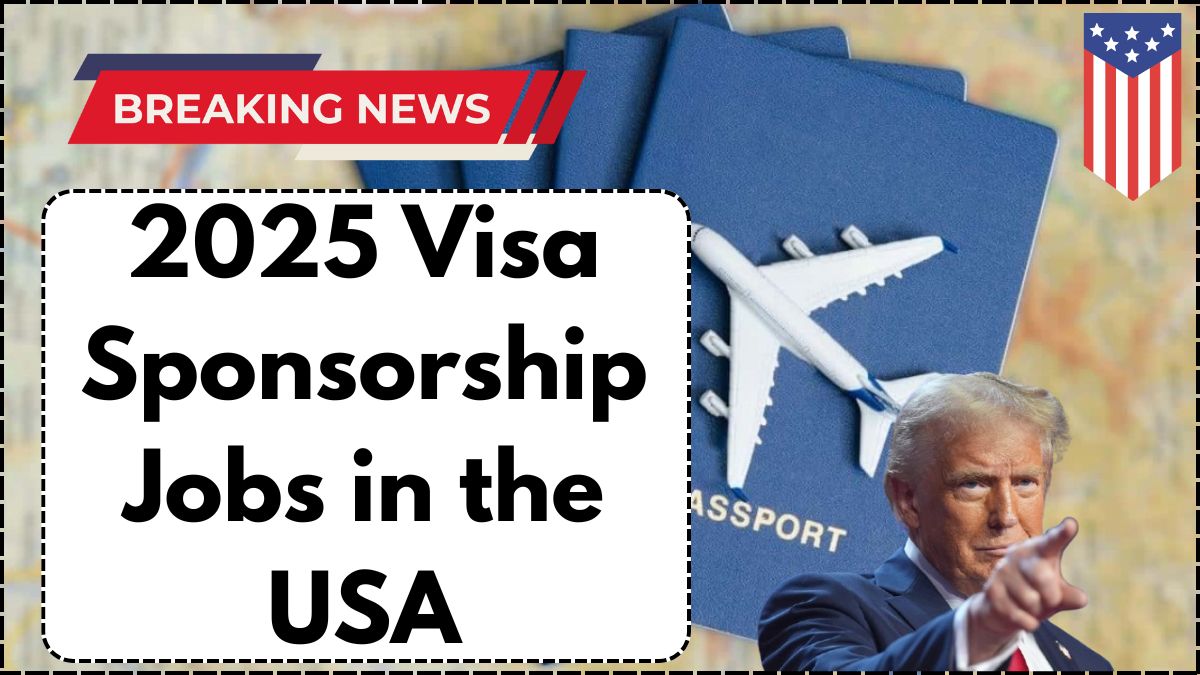Acquiring a skilled worker position in the United States with visa sponsorship is a long-cherished goal for many international professionals. As 2025 approaches, understanding the evolving job market, visa policies, and effective job search strategies is crucial for maximizing your chances of success. This guide explores high-demand industries, visa categories, and key steps to securing a U.S. job with visa sponsorship.

High-Demand Industries Offering Visa Sponsorship
Several industries in the U.S. face a shortage of skilled professionals and actively sponsor visas for foreign workers. Here are some of the most promising fields:
1. Technology and IT
The tech industry is expanding rapidly, creating a persistent demand for software developers, cybersecurity analysts, and data scientists. Leading tech giants such as Amazon, Google, and Microsoft frequently sponsor H-1B visas for international professionals. Additionally, startups and mid-sized firms seek global talent to drive innovation in artificial intelligence, cloud computing, and cybersecurity.
2. Healthcare and Medical Professions
The aging U.S. population has led to an ever-growing demand for healthcare workers. Positions such as doctors, registered nurses, medical technicians, and healthcare administrators are among the most sought-after roles. Hospitals, private clinics, and research institutions often provide visa sponsorship, particularly through H-1B and J-1 visa programs for medical professionals.
3. Engineering and Infrastructure Development
The U.S. government and private sector continue to invest in infrastructure and technological advancements, leading to high demand for civil, mechanical, electrical, and software engineers. Construction firms, aerospace companies, and energy corporations seek skilled professionals from abroad, frequently sponsoring L-1 and H-1B visas for eligible candidates.
4. Finance and Business Consulting
The finance industry, particularly multinational banks and investment firms, actively recruits international professionals with expertise in financial analysis, accounting, and investment consulting. Companies such as JPMorgan Chase, Goldman Sachs, and Deloitte often sponsor foreign workers with a global perspective on financial markets.
5. Education and Research
Academic institutions, research organizations, and think tanks often require international educators, scientists, and researchers. Universities frequently offer visa sponsorship through the O-1 visa for individuals with extraordinary abilities in academia and research.
Table: High-Demand Industries and Their Common Visa Types
| Industry | In-Demand Roles | Common Visa Types |
|---|---|---|
| Technology & IT | Software developers, Data scientists, Cybersecurity experts | H-1B, L-1 |
| Healthcare | Doctors, Nurses, Medical technicians | H-1B, J-1 |
| Engineering | Civil, Mechanical, Electrical Engineers | H-1B, L-1 |
| Finance | Accountants, Financial Analysts, Investment Consultants | H-1B, L-1 |
| Education & Research | Professors, Researchers, Scientists | O-1, H-1B |
Key Visa Categories for Skilled Workers
Understanding visa options is crucial when seeking employment in the U.S. Here are the primary visa types available for skilled workers:
1. H-1B Visa
The H-1B visa is one of the most popular choices for skilled foreign workers. It requires applicants to have at least a bachelor’s degree and is primarily granted for roles in technology, engineering, healthcare, and finance. This visa allows professionals to work in the U.S. for up to six years and provides a pathway to permanent residency.
2. L-1 Visa
The L-1 visa is designed for employees transferring from an international office of a multinational company to a U.S. branch. This is an excellent option for managers and specialists working for global corporations looking to expand operations in the U.S.
3. O-1 Visa
The O-1 visa is intended for individuals with extraordinary abilities in fields such as science, education, business, or athletics. Highly accomplished professionals, including researchers, executives, and industry experts, may qualify for this visa.
Steps to Securing a Job with Visa Sponsorship
If you are an international professional seeking employment in the U.S., follow these essential steps to enhance your chances of securing a job with visa sponsorship:
1. Research U.S. Companies That Sponsor Visas
Identify companies with a history of hiring foreign professionals. Many organizations in high-demand industries frequently sponsor work visas due to talent shortages. Websites like MyVisaJobs and the U.S. Department of Labor database provide valuable insights into such employers.
2. Tailor Your Resume and Cover Letter
Your resume and cover letter should highlight your specialized skills, international experience, and the unique value you bring to the company. Employers look for candidates who not only meet job requirements but also add strategic value to their teams.
3. Understand the Visa Process
Being well-versed in visa categories, application timelines, and documentation requirements will give you an advantage. Understanding the process allows you to discuss sponsorship confidently with potential employers.
4. Expand Your Professional Network
Networking plays a significant role in job acquisition. Join professional platforms like LinkedIn, attend industry conferences, and participate in job fairs to connect with recruiters and hiring managers. A referral from an industry professional can increase your chances of securing an interview.
5. Prepare for Visa-Specific Interviews
When interviewing with U.S. employers, emphasize your skills and how they align with the company’s needs. Be upfront about visa sponsorship requirements while demonstrating your enthusiasm for contributing to the organization’s success.
Navigating Policy Changes and Economic Conditions
Immigration policies and economic conditions significantly impact visa sponsorship availability. It is essential to stay informed about:
- Changes in U.S. Visa Policies: Different presidential administrations may revise visa quotas, eligibility criteria, or processing times.
- Economic Trends: A strong job market increases sponsorship opportunities, while economic downturns may result in more competitive hiring processes.
- Industry-Specific Demands: Keeping track of workforce shortages in your industry can help you target sectors more likely to sponsor visas.
Final Thoughts
Securing a skilled worker job with visa sponsorship in the U.S. is a competitive yet achievable goal. By targeting high-demand industries, understanding visa requirements, and optimizing your job search strategy, you can significantly improve your chances of success. Stay informed about policy changes, network strategically, and demonstrate your expertise to potential employers. With dedication and the right approach, your dream of working in the U.S. can become a reality.
Frequently Asked Questions (FAQs)
1. Which visa is the easiest to obtain for skilled workers?
The H-1B visa is the most common work visa, but it has an annual cap. The L-1 visa is easier for employees transferring within a multinational company.
2. Can I apply for a U.S. work visa without a job offer?
Most U.S. work visas require a job offer from a sponsoring employer. However, self-petitioned visas like the O-1 for extraordinary abilities may not need employer sponsorship.
3. What industries offer the most visa sponsorships?
Technology, healthcare, engineering, finance, and academia are among the top industries that frequently sponsor work visas.
4. How long does the visa sponsorship process take?
Processing times vary depending on the visa type, but the H-1B process typically takes several months due to the lottery system and documentation requirements.
5. Can I transition from a work visa to a Green Card?
Yes, many employers sponsor Green Cards for employees on H-1B and L-1 visas. The employment-based Green Card process can take several years but leads to permanent residency.
For More Information Click Here
Pari is a passionate writer known for captivating stories that blend imagination and reality. Inspired by travel, history, and everyday moments, Pari crafts narratives that resonate deeply with readers.
